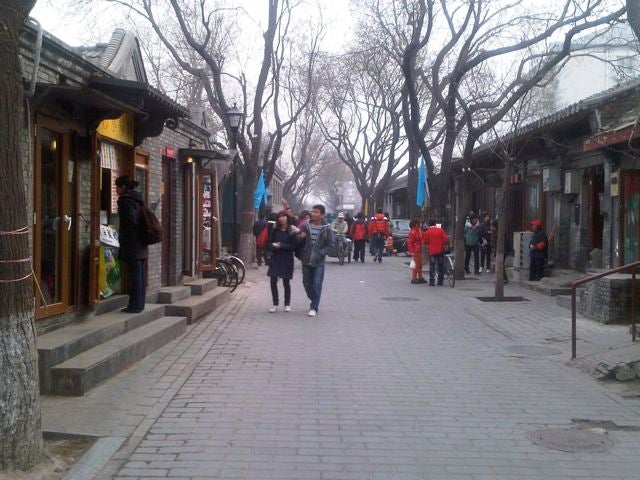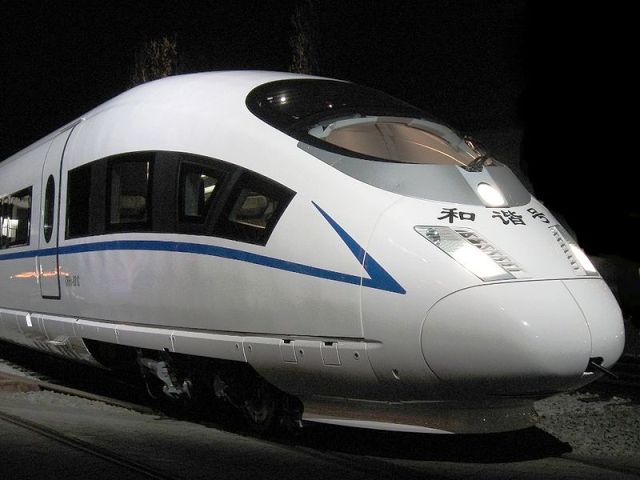Greetings from Beijing
March 22, 2010
EDITOR’S NOTE: This article has been updated from an earlier version posted Monday morning.
By Thomas J. Walsh
For PlanPhilly
On the second leg of a trade mission to China with representatives of the World Trade Center of Greater Philadelphia (WTCGP) and Drexel University’s LeBow College of Business, Planning and Zoning Code Commissioner Natalia Olson Urtecho writes that the skyline is not quite as impressive as Shanghai’s, and that she’s gotten in some sight-seeing.
The Forbidden City looks forbidding and exotic. The Great Wall looks tremendous. The trains? On time and very, very fast.
“On the high-speed train from Beijing to Tianjin, it took 28 minutes to cover 120 kilometers (74.5 miles),” she said. “By car it takes two hours.
Amazing – it is going [186 miles per hour] and it’s incredibly smooth. And it’s beautiful.”

“Ultra-modern” was another way she described the interior of the rail car. “China has built 42 high-speed railways and the U.S. has not built one. We have to do something about that, or we are going to be behind really quickly.”
Though it was not her intention, Olson Urtecho, in her role as a planning commissioner, is carrying on a Philadelphia tradition of sorts in Beijing. The city (then known as Peking) is where a young Edmund Bacon traveled for one of his many detailed foreign studies for what eventually became the standard text, “Design of Cities.”
Not surprisingly, perhaps, she ran into a Bacon fan in one of Beijing’s largest developers.
“It was not until 20 years or so ago that the mass scale of high-rises, commercial and residential, began shaping the landscape of Beijing,” Olson Urtecho wrote, over the weekend. “[The developer] had a great story. He said he remembers when Ed Bacon came to Beijing 30 years ago and gave a talk, and presented the grid concept of large boulevards, highways and rail systems crisscrossing through the city. Everyone laughed, saying, ‘That would never happen in Beijing.’
“Needless to say that is what Beijing is planned like today. The developer said that he couldn’t believe that the concepts that Bacon talked about would actually get implemented.”
She added: “The world is very small and it gives me great comfort, that in a small way, we have been able to be part of the amazing development of this great 2,000 year-old city.”
Trading places
The other tasks at hand seem to be getting more pressing as the trip moves along.
“Obama said he wants U.S. companies to double our exports to every nation, and when [Department of Commerce] Deputy Secretary Hightower was in Philadelphia last month, he spoke about the same thing,” Olson Urtecho also wrote.
The president announced his goal during the State of the Union address, and said he wants to do it in five years. “Those who once would oppose any trade agreement now understand that there are new markets and new sectors out there that we need to break into if we want our workers to get ahead,” Obama said in another speech.
Exactly how to double our exports though, “is going to be challenging, but it’s not impossible,” Olson Urtecho said. “It will require a cultural shift, of course. Americans have to start thinking more globally and need to really go out to the rest of the world and be more aggressive about international business. This is where the opportunities really are.”
An urban planner by trade and an entrepreneur, Olson Urtecho said that in order for businesses to do what Obama is asking, it will require creation of special programs at the state and city level, to market, advocate and incentivize businesses.
“We have a great model in Pennsylvania that could be replicated across the country,” she said. “Unfortunately funding was cut, even though it is mostly international companies who have opened up shop in Pennsylvania, and it was mostly due to that office and program.
“The candidate for governor that understands the need for this, and promises to build this program up, will get my vote and support. These international companies are going to be the ones providing jobs.”
Observing on a more immediate, ground level, Olson Urtecho said Beijing’s infrastructure appears to be in a state of flux. She has been told that the city has been erecting more public housing and apartment buildings, and evidently tearing down many of the shantytowns that caused such embarrassment from foreign press leading up to the 2008 Summer Olympics.
“I have not seen shantytowns because they have been getting rid of those,” she said. “There have been a lot of protests regarding historical preservation, though. The government demolished a lot of these old 300-plus-year-old commercial alleys, and people started to organize themselves and were able to preserve a few.”
One of the saved alleys is pictured below.

The trade mission continues through this week. Olson Urtecho’s involvement was prompted, in part, by a December visit arranged for some three dozen government officials and representatives from Chinese companies interested in creating extensions of their businesses in Philadelphia. She was invited to visit China by representatives of the city of Hebi and Henan Province.
The event, “Leading Change: Sustainability and the Future of Business, Technology, Policy, and the Environment in China and the U.S.,” was hosted by the Philadelphia International Sustainability Association of Business Students.
Linda Conlin, president of the WTCGP, said before that conference that China is a “priority market” for Philadelphia.
“It is very much in line with our efforts,” Conlin said in December, “to work with cities in focusing on sectors that have greater opportunities for growing high-value, high-tech jobs in the region.”
More: Read PlanPhilly’s “Postcard from China,” by Fred Kunda, published September 4, 2008.
Contact the reporter at thomaswalsh1@gmail.com.
WHYY is your source for fact-based, in-depth journalism and information. As a nonprofit organization, we rely on financial support from readers like you. Please give today.










